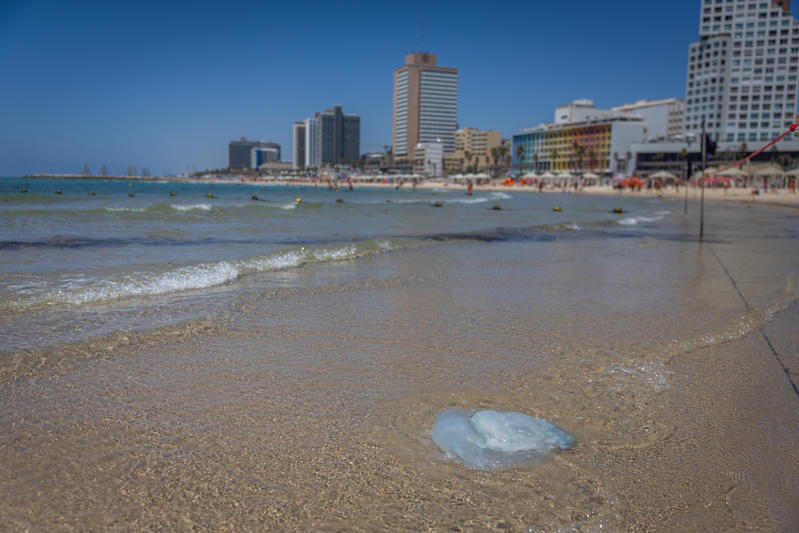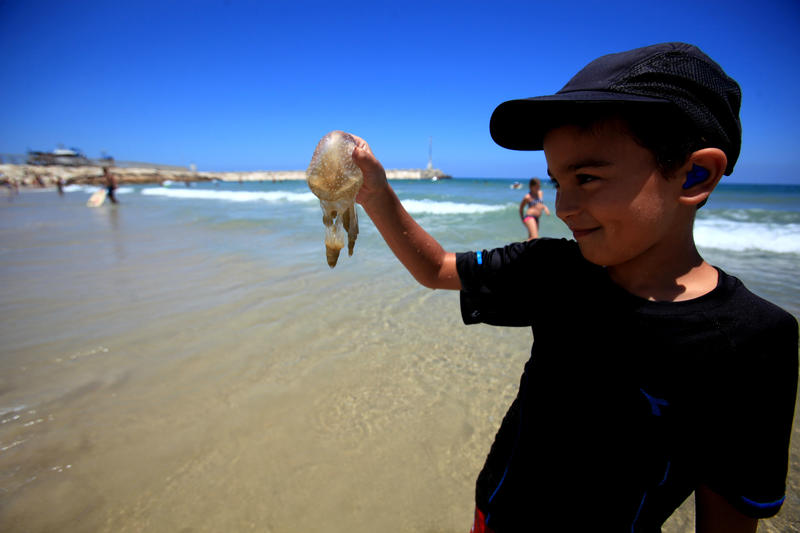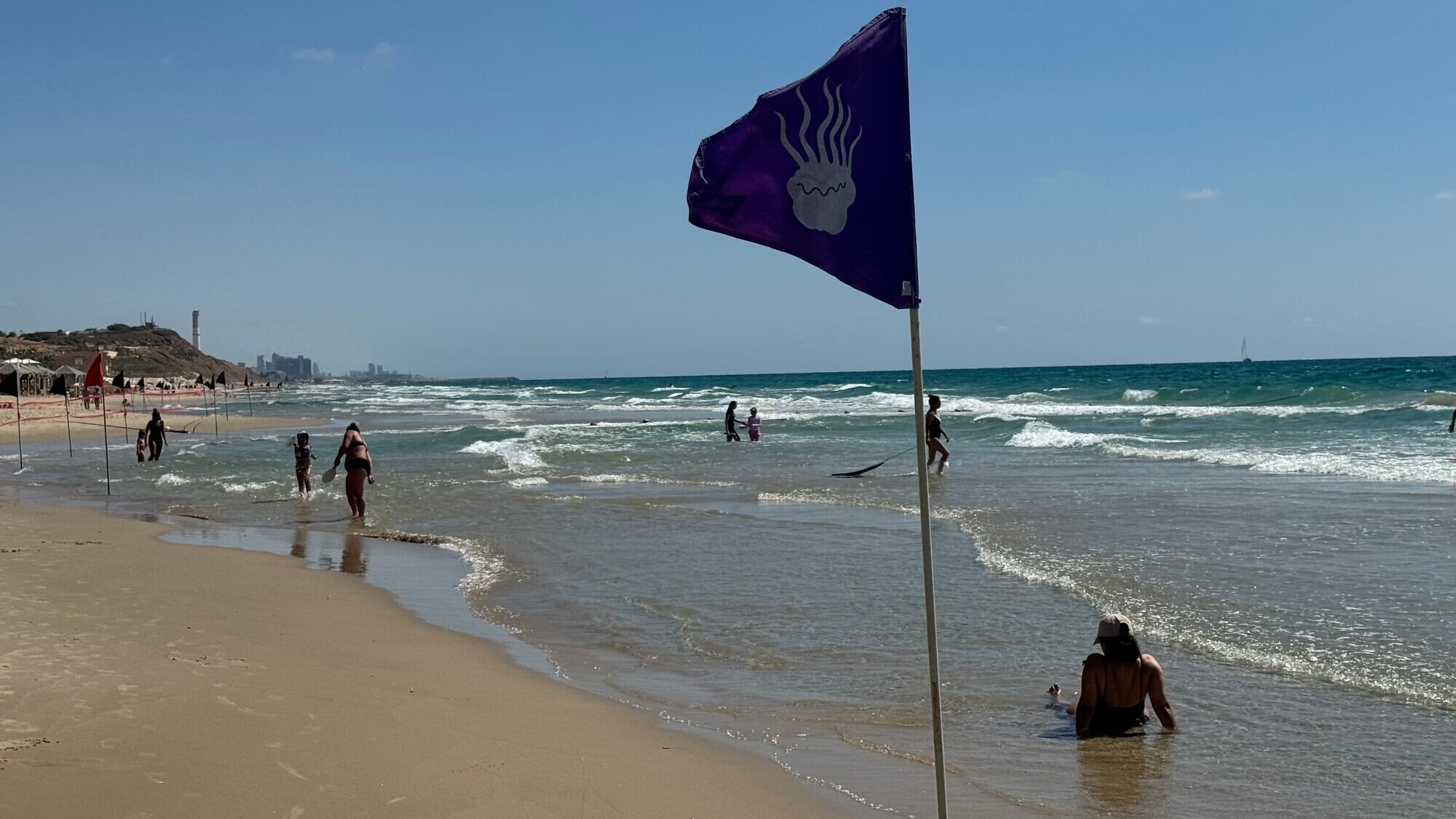(JNS) For Israeli parents of young children, a summer trip to the beach includes packing hats and sunscreen, towels and toys, water and snacks.
In recent years, it also means visiting a popular website, https://www.meduzot.co.il/overview-map, https://www.meduzot.co.il/for the latest information on jellyfish, known in Hebrew as meduzot.
Professor Dor Edelist, a marine macro-ecologist at the Leon Recanati Institute for Maritime Studies at the University of Haifa, could not be happier that word of the site is spreading.
Edelist tells JNS that each summer, between one and two million people visit the site, which has a jellyfish icon over various stretches of beaches along the Mediterranean Sea.
Since its founding in 2011, 5,000 to 6,000 people have opted to participate in “citizen science” by serving as voluntary reporters of the location, number and species of jellyfish they observe.
The main species of jellyfish in Israel is Rhopilema nomadic (the nomad jellyfish), although 16 other species may be spotted across the country’s beaches.
Millions of jellyfish have invaded the shores of Israel this summer, from popular beaches in the north, including Haifa and Netanya, to Tel Aviv and Herzliya in the center and Ashkelon and Ashdod in the south.
A 15-year-old girl was recently stung by a giant jellyfish while she was swimming at a beach in Netanya and was rescued by a local surfer. The traumatized girl was taken by ambulance to Meir Hospital in Kfar Saba, where she was hospitalized with second-degree burns.
Jellyfish recently clogged the cooling system at the Rutenberg Power Station in Ashkelon, which a team from the Israel Electric Corporation speedily deal with to prevent harm to the electricity supply. “We’re conducting continuous monitoring and are prepared for such cases but the quantities this year are exceptional,” the IEC said.
The website, which for now is in Hebrew only, offers links to “Have you seen a jellyfish? Submit a report,” a jellyfish reporter leaderboard (“We have much bigger plans for badges, etc.—right now it is just whoever had the most observations over the last week, month, year”), jellyfish species in Israel, a jellyfish photo contest, partner organizations and a contact form.
The site has faced some challenges. “We do our best and have few complaints, but there is zero guarantee” as to the accuracy of the reporting, says Edelist, who reports that “internet trolls” making continuous reports of jellyfish have at times compromised accuracy. His team has recently been using special software to detect such fake reports.
A second challenge for the site takes place “in the winter, when jellyfish are out, but people are not in the water [to report them], so we need to rely on seamen and divers,” Edelist adds.

Jellyfish lay on the sand at the beach in Tel Aviv on June 20, 2025. Photo by Chaim Goldberg/Flash90
Misconception about jellyfish
Dr. Zafrir Kuplik, a researcher and curator of the coelenterates collection at the Steinhardt Museum of Natural History at Tel Aviv University, says it is a “misconception” that jellyfish are only present in the summer and only in warm weather.
“You see them in the winter, but fewer,” he tells JNS. “They roam out at sea. They may be remains of the summer swarms.”
Kuplik shares that the presence of jellyfish is a “function of their life cycle” and that they are “current dependent.” Kuplik points out that jellyfish can be seen in water bodies around the world, including the North Sea.
Kuplik and Edelist are part of a close-knit community of Israeli jellyfish researchers who share a love for jellyfish and strive to provide an accurate picture of these aquatic animals that, they point out, belong to the Phylum Cnidaria and the marine class Scyphozoa.
“You can count jellyfish experts on one hand,” notes Edelstein playfully. He is a self-described fish specialist who became interested in jellyfish 15 years ago while working on his PhD. At the time, a colleague invited him to observe jellyfish polyps under a microscope—and he was hooked.
Something about these polyps, which eventually produce a dozen or more juvenile jellyfish, excited him. “It hit me that jellyfish are not a problem to solve, but a challenge to deal with,” he says.
One challenge jellyfish pose is that they visit Israeli beaches every summer from mid-June to mid-August and sometimes do sting human beings. But there are precautions swimmers can take, such as consulting the website or visiting a map prior to setting out for the beach.
Edelist is pleased that the map of jellyfish whereabouts also appears on the weather page of some news websites. Beaches where there is a concern by the authorities about jellyfish display a bright purple flag with a white jellyfish on it.

A young boy plays with a dead jellyfish on the beach of Ashkelon, July 06, 2013. Photo by Flash 90
Ministerial oversight
The Israeli Ministry of Environmental Protection, headed by Minister Idit Silman, is ultimately responsible for managing jellyfish populations in Israel, especially their impact on coastal areas and power plants.
A ministry official told JNS that it is “well aware of the jellyfish issue in Israel. The ministry has been funding national monitoring of the marine environment at all levels for decades.”
The ministry’s website offers (in English) “First Aid Care for Jellyfish Sting.” It explains that jellyfish travel to the Israeli coasts every summer as the Mediterranean Sea warms up, and that they use their tentacles to sting and emit a venom which can lead to a rash, redness, pain or swelling. Washing the affected area first with seawater, then with fresh water, is useful. (www.gov.il/en/pages/jellyfish-sting-care).
Applying aloe is also effective. Edelist notes that wearing lycra or a diving suit can be beneficial.
A visit to the beach
On a recent late afternoon visit to the lifeguard station at the Hilton Tzafon (North) Beach, lifeguard Alexi remarks that it is not very crowded today due to the jellyfish. “There are no jellyfish in the pool!” he quips, pointing to the nearby Gordon Pool.
He explains that when the water gets very warm in the summer, the jellyfish come close to shore. He shows me the aloe plants in planters along the boardwalk near the snack bar and explains that—consistent with EPA recommendations—they offer fresh aloe to beachgoers in the event of a sting.
Edelist, somewhat concerned that jellyfish get a bad reputation, stresses that jellyfish “have no desire to waste precious sting cells” on people. They “just drift passively” and tend to “swim away from you—so their stingers are facing toward you.” He notes that they sense various creatures with their receptors.
Kuplik similarly feels the Israeli public has misconceptions about jellyfish, often considering them “like mosquitoes,” and not understanding “why we need them.”
He notes that jellyfish are “eaten by all—fish, sea turtles, invertebrates, marine mammals and sea birds. And if they are not eaten, the biomass dies, sinks and disintegrates by bacterial activation. Non-organic substances are spread to the ocean and enrich the water all over again.”
Edelist and Kuplik acknowledge some negative aspects of jellyfish, beyond stinging humans. Kuplik notes their interference at times in fisheries, tourist activities and clogging of cooling inlets.
Edelist quantifies the impact. “They clog intakes and filters of power and desalination plants and these damages were estimated by the State Comptroller as $32 million per year,” he says.
Still, Kuplik remains an outspoken advocate for meduzot. “People notice jellyfish because of the negative. I’m more interested in the positive,” he concludes.














